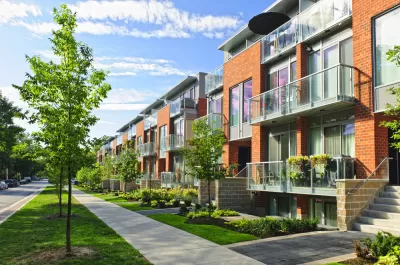Missing middle housing? Ending single-family zoning? How language impacts public opinion in the movement to increase housing density.

As cities and states around the country look to update their zoning codes to allow for more housing density, the language used around zoning reform can make a big difference in how initiatives are received.
As Teo Armus explains in the Washington Post, the framing of proposed zoning changes colors the way people view them, painting upzoning as either a threat to traditional neighborhoods or a boost to housing affordability.
Advocates say expanding housing supply would open expensive enclaves to more people, undoing policies once meant to keep out people of color. Opponents express concerns the changes would overwhelm local infrastructure and spoil what made these areas so attractive in the first place.
The phrase “ending single-family zoning,” which has been frequently used by media including Planetizen, “is an imprecise way of describing the change” because it “doesn’t tell you what it’s going to turn into,” says Jenny Schuetz, urban economist and senior fellow at the Brookings Institution. For people who fear the single-family home next door will be torn down in favor of a high-rise tower, language that more clearly explains the type of new housing that could be built—such as the increasingly popular ‘missing middle housing’—could assuage some of their fears.
According to Jason Jordan, public affairs director at the American Planning Association, “We have to be sensitive and try to find a vocabulary … that avoids the technical jargon debate or this very polarized culture-war debate over whether the suburbs are good or bad.”
FULL STORY: The battle over single-family zoning is also a fight over what to call it

Planetizen Federal Action Tracker
A weekly monitor of how Trump’s orders and actions are impacting planners and planning in America.

San Francisco's School District Spent $105M To Build Affordable Housing for Teachers — And That's Just the Beginning
SFUSD joins a growing list of school districts using their land holdings to address housing affordability challenges faced by their own employees.

The Tiny, Adorable $7,000 Car Turning Japan Onto EVs
The single seat Mibot charges from a regular plug as quickly as an iPad, and is about half the price of an average EV.

Seattle's Plan for Adopting Driverless Cars
Equity, safety, accessibility and affordability are front of mind as the city prepares for robotaxis and other autonomous vehicles.

As Trump Phases Out FEMA, Is It Time to Flee the Floodplains?
With less federal funding available for disaster relief efforts, the need to relocate at-risk communities is more urgent than ever.

With Protected Lanes, 460% More People Commute by Bike
For those needing more ammo, more data proving what we already knew is here.
Urban Design for Planners 1: Software Tools
This six-course series explores essential urban design concepts using open source software and equips planners with the tools they need to participate fully in the urban design process.
Planning for Universal Design
Learn the tools for implementing Universal Design in planning regulations.
Smith Gee Studio
City of Charlotte
City of Camden Redevelopment Agency
City of Astoria
Transportation Research & Education Center (TREC) at Portland State University
US High Speed Rail Association
City of Camden Redevelopment Agency
Municipality of Princeton (NJ)





























